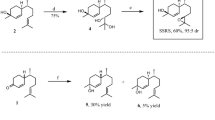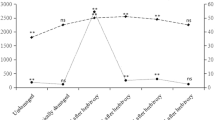Abstract
The stink bug Leptocorisa chinensis (Hemiptera: Alydidae), which causes pecky rice grains, emits pungent volatiles when disturbed. To study ecological functions of the volatiles, we investigated the responses of adult L. chinensis in a small observation arena. When an undisturbed individual of the same gender was introduced into the arena, the initially occupying L. chinensis did not show any behavioural responses. However, when a disturbed conspecific of the same gender was introduced, the initial occupant was excited immediately and escaped from the arena through the hole, suggesting that the pungent volatiles from a disturbed conspecific caused excitement/escape behaviour. Chemical analyses using a gas chromatograph–mass spectrometer showed that disturbed adults of both sexes emitted octanal, (E)-2-octenal, octanol, hexyl acetate, (Z)-3-octenyl acetate, octyl acetate and (E)-2-octenyl acetate. (E)-2-Octenal was the major compound. When exposed to (E)-2-octenal and to (E)-2-octenyl acetate, undisturbed females were excited and escaped from the observation arena with a similar proportional response as to disturbed females. Males and females escaped from (E)-2-octenal at ca. 2–10 ppbV in a mesh cage. The possible use of the volatile compounds eliciting excitement/escape behaviour in L. chinensis for control of this species in paddy fields is discussed.




Similar content being viewed by others
References
Aldrich JR (1995) Chemical communication in the true bugs and parasitoid exploitation. In: Cardé RT, Bell WJ (eds) Chemical ecology of insects II. Chapman and Hall, New York, pp 318–363
Blum MS (1985) Alarm pheromones. In: Kerkut GA, Gilbert LI (eds) Comprehensive insect physiology, biochemistry and pharmacology, vol 9. Pergamon, Oxford, pp 193–224
Fukatsu T, Watanabe T, Hu H, Yoichi H, Hirafuji M (2012) Field monitoring support system for the occurrence of Leptocorisa chinensis Dallas (Hemiptera: Alydidae) using synthetic attractants, field servers, and image analysis. Comput Electron Agric 80:8–16
Grist DH, Lever RJAW (1969) Pests of rice, tropical science series. Longmans Green, London
Gunawardena NE, Bandumathie MK (1993) Defensive secretion of rice bug Leptocorisa oratorius Fabricius (Hymenoptera, Coreidae)—a unique chemical combination and its toxic, repellent and alarm properties. J Chem Ecol 19:851–856
Ito K (2004) The role of the feeding habits of Trigonotylus caelestialium (Kirkaldy) (Heteroptera: Miridae) on the production of pecky rice grains with special reference to the occurrence of split-hull paddy. Jpn J Appl Entomol Zool 48:23–32
Leal SW, Ueda Y, Ono M (1996) Attractant pheromone for male rice bug, Leptocorisa chinensis: semiochemicals produced by both male and female. J Chem Ecol 22:1429–1437
Takeuchi H (2007) Population dynamics of Leptocorisa chinensis (Hemiptera: Alydidae) and forecasting of damage occurrence in rice fields. Bull Natl Agric Res Center 9:17–74
Takeuchi H, Watanabe T, Suzuki Y (2004) Ripening stages of rice spikelets selectively damaged by four species of rice bugs, Leptocorisa chinensis Dallas (Hemiptera: Alydidae), Lagynotomus elongatus (Dallas) (Hemiptera: Pentatomidae), Cletus punctiger (Dallas) (Hemiptera: Coreidae) and Stenotus rubrovittatus (Matsumura) (Hemiptera: Miridae). Jpn J Appl Entomol Zool 48:281–287
Wardle AR, Borden JH, Poerce HD Jr, Gries (2003) Volatile compounds released by disturbed and calm adults of the tarnished plant bug, Lygus lineoraris. J Chem Ecol 29:931–944
Watanabe T, Takeuchi H, Ishizaki M, Yasuda T, Tachibana S, Sasaki R, Nagano K, Okutani-Akamatsu Y, Matsuki N (2009) Seasonal attraction of the rice bug, Leptocorisa chinensis Dallas (Heteroptera: Alydidae), to synthetic attractant. J Appl Entomol Zool 44:155–164
Acknowledgments
We thank Yoshito Suzuki, Toshikazu Adachi, Hiroaki Fujimoto, Atsuo Akayama, Yoshiki Takashima and two anonymous reviewers for their useful comments. This study was supported by the Research Project for Utilizing Advanced Technologies in Agriculture, Forestry, and Fisheries (Ministry of Agriculture, Forestry, and Fisheries, Japan).
Author information
Authors and Affiliations
Corresponding author
About this article
Cite this article
Yamashita, Ki., Isayama, S., Ozawa, R. et al. A pecky rice-causing stink bug Leptocorisa chinensis escapes from volatiles emitted by excited conspecifics. J Ethol 34, 1–7 (2016). https://doi.org/10.1007/s10164-015-0437-5
Received:
Accepted:
Published:
Issue Date:
DOI: https://doi.org/10.1007/s10164-015-0437-5




